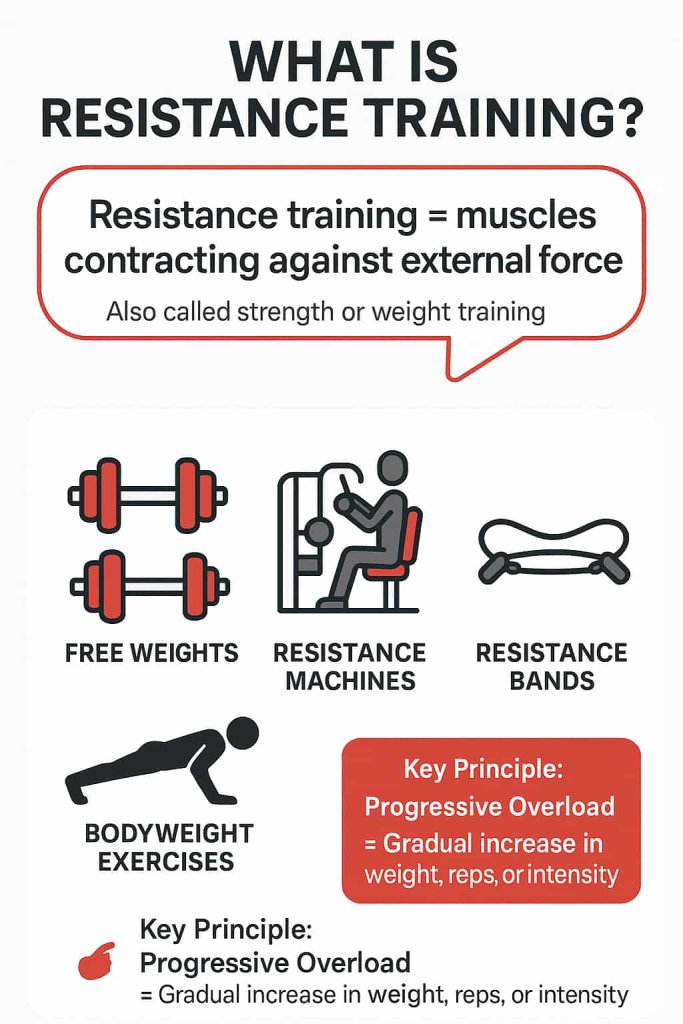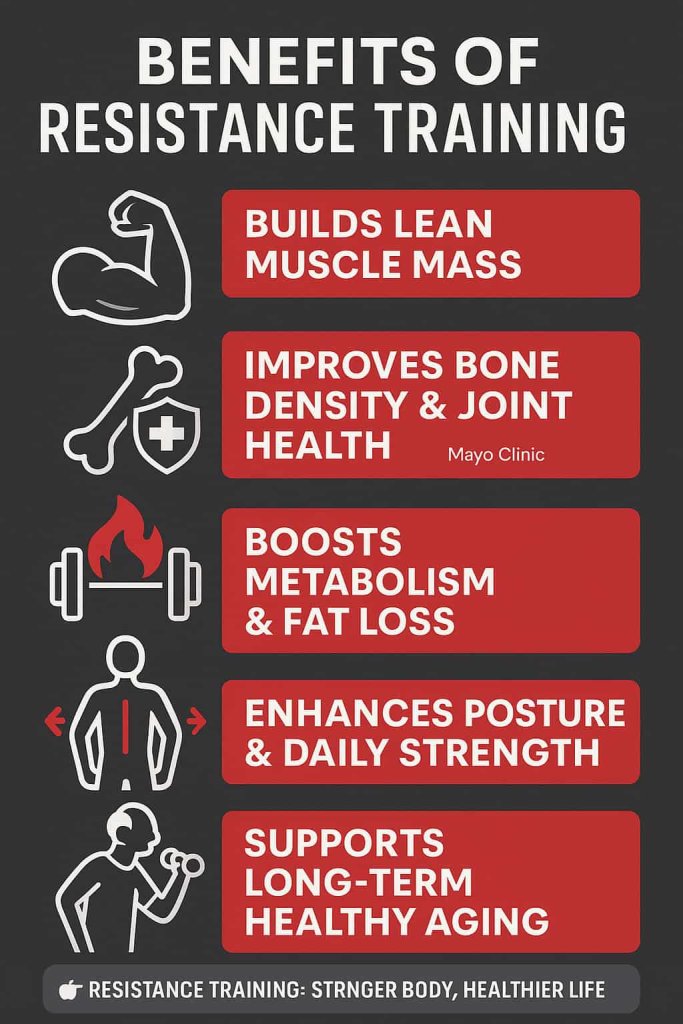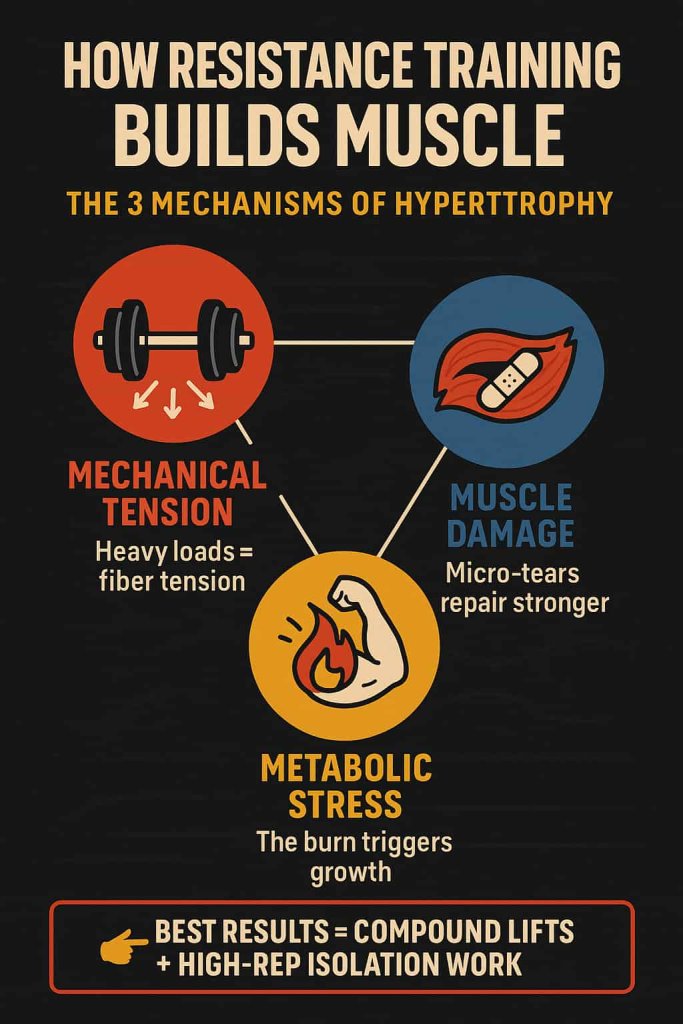Yes, resistance training is one of the most effective ways to build muscle, strength, and overall fitness.
By challenging your muscles against external resistance—whether from free weights, machines, bands, or even your own bodyweight—you force them to adapt, grow stronger, and increase in size.

Resistance training is the foundation of muscle growth, athletic performance, and long-term health. With the right exercises and progressive overload, you can boost strength, improve posture, strengthen bones, and accelerate metabolism.
In this guide, we’ll cover 7 proven resistance training exercises for muscle growth, explain why they work, and show you how to apply them effectively.
What Is Resistance Training?
Resistance training (also called strength or weight training) involves exercises where muscles contract against an external force.

This force can come from:
- Free weights (dumbbells, barbells)
- Resistance machines
- Bodyweight exercises
- Resistance bands
The key principle is progressive overload—gradually increasing weight, reps, or intensity so your muscles continue to adapt and grow (Wikipedia – Progressive Overload).
Benefits of Resistance Training

- Builds lean muscle mass
- Improves bone density and joint health (Mayo Clinic)
- Boosts metabolism and fat loss
- Enhances posture and daily functional strength
- Supports long-term healthy aging
7 Proven Exercises for Muscle Growth
1. Squats – The King of Lower Body Strength
Squats are often called the “king of exercises” because they recruit multiple muscle groups at once.
Muscles Worked: Quadriceps, hamstrings, glutes, core.
Benefits: Builds total lower-body strength, boosts testosterone and growth hormone release, enhances athletic performance.
How to Do It:
- Stand with feet shoulder-width apart.
- Keep your chest up, brace your core, and lower until thighs are parallel.
- Drive through your heels to return to standing.
👉 For added intensity, progress from bodyweight to barbell squats.
2. Deadlifts – Full-Body Power Builder
The deadlift develops the posterior chain and teaches you how to lift heavy objects safely.
Muscles Worked: Hamstrings, glutes, lower back, traps, core.
Benefits: Builds full-body strength, grip power, and muscle mass.
How to Do It:
- Stand with feet hip-width, barbell over mid-foot.
- Hinge at hips, grip the bar, keep back flat.
- Push through heels and extend hips to stand tall.
👉 Deadlifts are unmatched for posterior strength and muscle growth.
3. Bench Press – Upper Body Mass Builder
A gym classic, the bench press targets pressing muscles for chest development.
Muscles Worked: Pectorals, deltoids, triceps.
Benefits: Builds upper-body size and pressing strength.
How to Do It:
- Lie on a bench with barbell above chest.
- Lower bar to mid-chest under control.
- Press upward until arms are extended.
👉 Dumbbell bench press can improve range of motion and stability.
4. Rows – Back Thickness and Stability
Rowing variations strengthen your back and balance pressing exercises.
Muscles Worked: Lats, rhomboids, traps, rear delts, biceps.
Benefits: Builds thickness in the back and improves posture.
How to Do It:
- Hinge forward at hips, holding barbell or dumbbells.
- Pull weight toward lower ribs.
- Squeeze shoulder blades together, then lower.
👉 Inverted rows are a great beginner-friendly option.
5. Pull-Ups – Vertical Pull Strength
Pull-ups are a true test of relative strength and build a wide, muscular back.
Muscles Worked: Lats, biceps, forearms, shoulders, core.
Benefits: Improves back width and grip strength.
How to Do It:
- Grip a pull-up bar, palms facing away.
- Engage core and pull chin above bar.
- Lower slowly with control.
👉 If you can’t do bodyweight pull-ups yet, start with assisted bands or lat pulldowns.
6. Walking Lunges / Bulgarian Split Squats – Unilateral Strength
Single-leg exercises correct imbalances and increase lower-body activation.
Muscles Worked: Quads, glutes, hamstrings, calves.
Benefits: Improves balance, stability, and athletic performance.
How to Do Walking Lunges:
- Step forward into a lunge, back knee just above the ground.
- Push through front heel to step forward into next lunge.
How to Do Bulgarian Split Squats:
- Place one foot on a bench behind you.
- Lower into a lunge, keeping torso upright.
- Drive through front leg to stand tall.
7. Push-Ups / Dips – Bodyweight Pressing Power
Bodyweight movements are simple but effective for upper-body mass.
Muscles Worked: Chest, shoulders, triceps, core.
Benefits: Builds pressing strength without equipment.
How to Do Push-Ups:
- Hands shoulder-width, body straight.
- Lower chest to floor, then press back up.
How to Do Dips:
- Grip parallel bars.
- Lower body until elbows bend 90°.
- Push back to lockout.
How Resistance Training Builds Muscle (Science of Hypertrophy)

Muscle growth happens through three main mechanisms:
- Mechanical Tension → Lifting heavy or challenging loads creates tension on muscle fibers.
- Muscle Damage → Micro-tears occur during training, and muscles repair stronger during recovery.
- Metabolic Stress → The “burn” or pump from higher-rep training triggers cellular adaptations.
👉 For best results, combine compound lifts (for tension and damage) with higher-rep isolation work (for metabolic stress).
Common Mistakes to Avoid in Resistance Training
Even the best exercises won’t deliver results if done incorrectly. Watch out for these pitfalls:
- Ego Lifting → Using too much weight with poor form leads to injuries.
- Skipping Compound Lifts → Relying only on isolation moves limits overall growth.
- Inconsistent Training → Muscles need regular, progressive overload to grow.
- Neglecting Recovery → Muscles grow during rest, not just in the gym.
- Poor Nutrition → Without enough protein and calories, growth stalls.
👉 Solution: Train smart, stay consistent, and balance lifting with proper sleep and nutrition.
Sample Weekly Resistance Training Plan
| Day | Focus | Example Exercises |
|---|---|---|
| Monday | Lower Body Strength | Squats, Lunges |
| Tuesday | Upper Body Push | Bench, Push-Ups |
| Wednesday | Rest or Active Recovery | Walking, Mobility |
| Thursday | Posterior Chain | Deadlifts, Rows |
| Friday | Upper Body Pull | Pull-Ups, Rows |
| Saturday | Mixed Strength & Core | Squats, Dips |
| Sunday | Rest | Recovery |
Tips for Muscle Growth
- Train 2–4 times per week depending on recovery.
- Use progressive overload (increase weight, reps, or intensity).
- Aim for 6–12 reps per set for hypertrophy.
- Rest 60–90 seconds between sets.
- Eat a protein-rich diet (1.6–2.2 g/kg body weight).
FAQ – Resistance Training for Muscle Growth
1. How many times per week should I do resistance training?
2–4 sessions per week are effective for most people, depending on recovery.
2. Do I need heavy weights to build muscle?
No. Studies show lighter weights taken close to failure can also build muscle (The Guardian, 2025).
3. Can bodyweight exercises build muscle?
Yes—push-ups, dips, and pull-ups are excellent for strength and hypertrophy.
4. How long before I see results?
With consistent training and proper nutrition, noticeable results often appear in 6–12 weeks.
5. Should beginners focus on machines or free weights?
Both work, but beginners may benefit from machines initially for safety and stability.
6. Is resistance training safe for older adults?
Yes, when done properly. It helps maintain bone density, mobility, and strength with age.
7. How important is diet in muscle growth?
Critical. Without sufficient protein and calories, resistance training won’t maximize results.
Conclusion
Resistance training is the fastest and most reliable way to build muscle and strength.
By mastering squats, deadlifts, bench press, rows, pull-ups, lunges, and push-ups/dips, you can train every major muscle group effectively.
Start with proper form, progress gradually, and fuel your body with the right nutrition. Consistency is the secret—commit to these exercises and watch your strength and physique transform.
👉 Ready to start building muscle? Choose 3–4 of these exercises today and add them to your workout plan!
